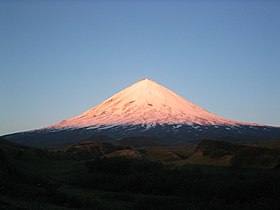Kluchevskaya
| Klyuchevskoy | |
|---|---|

Klyuchevskaya Sopka in January 2007
|
|
| Highest point | |
| Elevation | 4,750 m (15,580 ft) |
| Prominence | 4,649 m (15,253 ft) Ranked 13th |
| Isolation | 2,748 kilometres (1,708 mi) |
| Listing | Ultra |
| Coordinates | 56°03′22″N 160°38′39″E / 56.056044°N 160.644089°ECoordinates: 56°03′22″N 160°38′39″E / 56.056044°N 160.644089°E |
| Geography | |
| Location | Kamchatka, Russia |
| Geology | |
| Mountain type | Stratovolcano (active) |
| Last eruption | 2015–2017 |
| Climbing | |
| First ascent | 1788 by Daniel Gauss and 2 others |
| Easiest route | basic rock/snow climb |
Klyuchevskaya Sopka (Russian: Ключевская сопка; also known as Klyuchevskoi, Russian: Ключевской) is a stratovolcano, the highest mountain on the Kamchatka Peninsula of Russia and the highest active volcano of Eurasia. Its steep, symmetrical cone towers about 100 kilometres (60 mi) from the Bering Sea. The volcano is part of the natural Volcanoes of Kamchatka UNESCO World Heritage Site.
Klyuchevskaya's first recorded eruption occurred in 1697, and it has been almost continuously active ever since, as have many of its neighboring volcanoes. It was first climbed in 1788 by Daniel Gauss and two other members of the Billings Expedition. No other ascents were recorded until 1931, when several climbers were killed by flying lava on the descent. As similar dangers still exist today, few ascents are made.
Klyuchevskaya Sopka is considered sacred by some indigenous peoples, being viewed by them as the location at which the world was created. Other volcanoes in the region are seen with similar spiritual significance, but Klyuchevskaya Sopka is the most sacred of these.
Beginning in early January 2007, the Klyuchevskaya volcano began another eruption cycle. Students from the University of Alaska Fairbanks and scientists of the Alaska Volcano Observatory traveled to Kamchatka in the spring to monitor the eruption. On 28 June 2007, the volcano began to experience the largest explosions so far recorded in this eruption cycle. An ash plume from the eruption reached a height of 10 km (33,000 ft) before drifting eastward, disrupting air traffic from the United States to Asia and causing ashfalls on Alaska's Unimak Island.
...
Wikipedia

